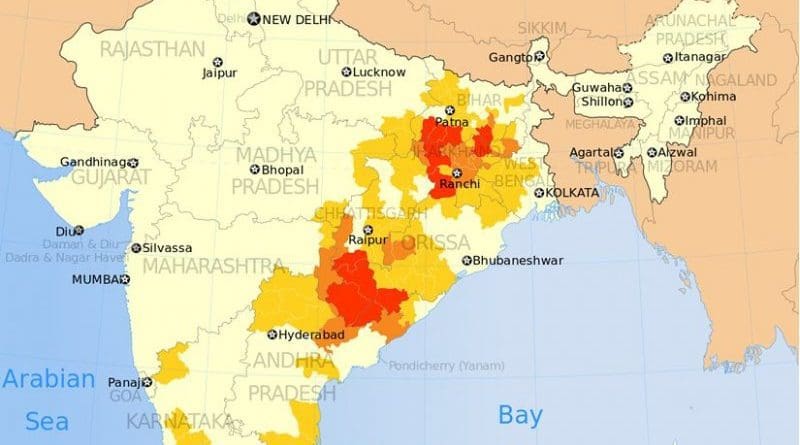Maoist Abductions: How Long Will We Make Deals? – OpEd
It appeared too good to be true — Maoists letting go of their high-profile hostage after holding him for 12 long days without expecting much in return. As soon as District Collector Alex Menon in Chhattisgarh’s Sukma district was released from Maoist captivity on May 3, Chief Minister Raman Singh indicated that there was no secret deal between the government and the left-wing ultras.
“It is for everybody to see,” he boasted. Singh had to be seen to have done better than Chief Minister Naveen Patnaik of neighbouring Odisha.
The government led by Patnaik had released five Maoist cadres/sympathisers in exchange for two Italians and a Member of Legislative Assembly held hostage by Maoists since March.
The “transparent” agreement between the Chhattisgarh government and the Communist Party of India-Maoist, copies of which were freely circulated by the state government officials, included constitution of a standing committee which will regularly review cases of jailed Maoist cadres against whom investigation and prosecution is pending, on a priority basis.
The government also agreed to provide relief in all cases of human rights violations. The three-member standing committee became functional within an hour of Menon’s release.
It took merely a day for the facade to come off. On May 4, a bail application was moved in the court for the release of two hardcore Maoist cadres — Meena Chaudhary and Malti alias Shantipriya Reddy. The latter is the wife of the CPI-Maoists’ Dandakaranya Special Zonal Committee spokesman Gudsa Usendi. Both had figured in the original list of eight Maoists whose release had been demanded by the outfit after Menon’s abduction.
The Chhattisgarh government’s counsel, with a history of regularly opposing bails to so- called Maoist sympathisers such as Dr Binayak Sen and Soni Sori, did not oppose the bail “in public interest and under changed circumstances”.
Police officials were quoted as saying that this is a “normal” procedure and is certainly not part of any deal between the government and the extremists. Maoist interlocutor B D Sharma, however, spilled the beans.
“Yes there was an understanding that the government will not oppose bail (to them),.” he said. Even the government counsel later chipped in to say that he was directed by the state government not to oppose bail. Fortunately, the court rejected the bail applications.
It isn’t too difficult to see which side has won the battle.
Chief Minister Raman Singh now demands a national hostage policy. He wishes to raise this issue with the Union home minister and the prime minister. However, it is not clear what prevented him from acting tough on his own.
Why could Chhattisgarh not set a precedent and an example for other states? Why were the ‘secret’ as well as the ‘transparent’ deals struck, when the extremists had clearly come under pressure from their own protagonists?
Among the thousand pieces of advice that poured in after the recent abductions were those put forth by former home secretary G K Pillai and former Border Security Force director General E N Rammohan. Both advocated a line which would be considered too tough.
Pillai said, “We should just tell the Maoists to go ahead and kill them and we’ll see. Tell them that if anything happens to the collector, then your people are also going to be in trouble.”
Toeing a similar line, Rammohan said, “So if the collector was foolhardy enough and got kidnapped, okay, you do what you want with him, we can get 100 collectors.”
Views like this will be always in a minority in the policy making circle for two reasons. First, since the country has a precedence of releasing “dreaded” terrorists in exchange of “innocent” civilians, to break from such a shady past would be politically sensitive. Secondly, such a position is intrinsically linked to the state’s capacity to take counter-measures in case the extremists decide to harm their hostage.
Since none of the states currently have the capacity to enforce such a solution on the Maoists, their policies have been marked by significant tentativeness and not surprisingly, these have been exploited by the extremists. Unless the state is in a position to enforce its will on the extremists, its vulnerability will eventually have to be translated into capitulation of various forms — transparent as well as secret.
The ministry of home affairs, pursuing a hands-off policy for the moment, reportedly has sent a directive to the states to formulate their own Standard Operating Procedures to avoid hostage situations involving officials and politicians.
However, it is unimaginable that abductions will come to a halt, now that the Maoists have tasted blood in Odisha and Chhattisgarh. Unless of course the state governments decide to lock all their bureaucrats and politicians inside barricaded forts.
Unless New Delhi decides to implement a consensus policy of effective domination of all the areas that are under extremist control today, no amount of ad hoc measures comprising policy of negotiation, appointment of negotiators, development-led initiatives etc is going to work. This issue needs urgent attention as time is running out.
This article appeared at Rediff and is reprinted with permission.

